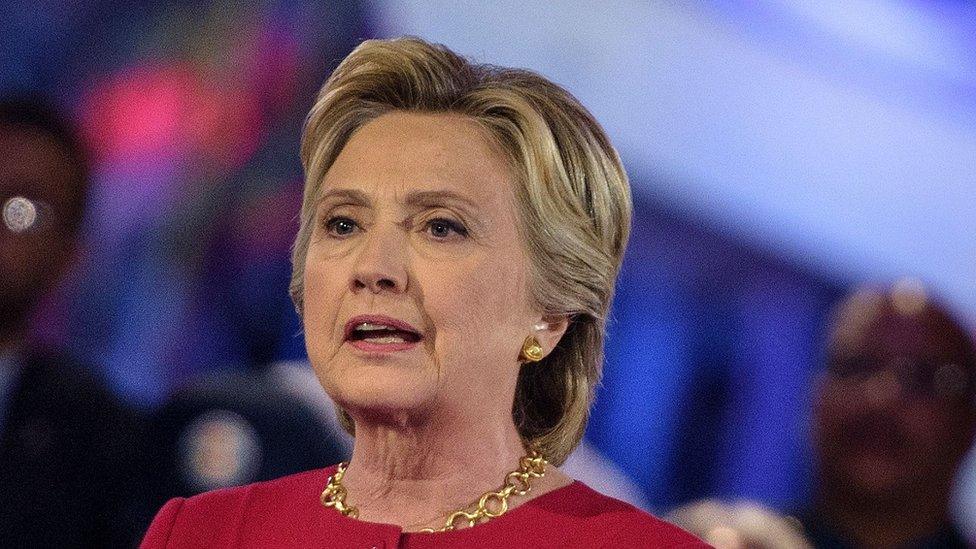Conspiracy theories: How to be a smarter news consumer
- Published

This election cycle, more users than ever before are turning to social media - and as a result, it can be difficult to separate reported fact from rampant speculation. The BBC's Charlie Northcott discovers how to spot a conspiracy theory.
Conspiracy theories, a common feature in many elections, have run amok in a new climate where scuttlebutt travels round the world on social media before the mainstream media can get its boots on.
On Twitter, rumours, external that Hillary Clinton uses a body double to hide her health problems run alongside mainstream media reports about her contracting pneumonia.
Donald Trump hasn't been spared either.
Some say he is a Russian spy, while others suggest he is really plotting to win the election for his rival, Hillary Clinton.
The BBC has spoken with four fact-checking and lie-detection experts. This is their guide to spotting conspiracy theories in the news.


Conspiracy theorists still insist Vice-President Dick Cheney was the secret mastermind behind 9/11
Secrecy
What do the claims that Hillary Clinton is scheming to ban Christian churches, external and that Donald Trump is conspiring to destroy the Republican party, external have in common? Both involve a secret plot.
Hatching nefarious schemes behind closed doors is often a tell-tale sign of a conspiracy theory.
"If someone asserts something is going on in secret, alarm bells should be going off in your head," says Joseph Uscinski, associate professor of political science at the University of Miami and author of American Conspiracy Theories.
"People acting in secrecy is a necessary feature of a conspiracy theory, as it cannot be disproved."
Claiming a heinous plot is underway gives cover to even the most outlandish claims.
"The idea that 1% of America is secretly controlling the rest. Or that George Bush secretly plotted to blow up the Twin Towers. These ideas persist, with no evidence, because their 'secrecy' makes them impossible to verify."
The truth is, it's very difficult keep a secret plot secret, which ties into the next tell-tale sign of a conspiracy.


Conspiracy theorists contend that the government faked the Sandy Hook shooting as a way to enact more restrictive gun legislation, and that the families were actually paid actors
Scale
American politicians have engaged in serious cases of subterfuge and real conspiracy historically, from Bill Clinton's misrepresentation of his affair with Monica Lewinsky to Richard Nixon's deceit during the Watergate scandal.
"It is reasonable to suspect government," says Michael Shermer, publisher of Skeptic Magazine, external. "Governments do lie."
But distinguishing between true conspiracies and false theoretical ones is difficult.
One way to go about it is to think about scale.
"The more people allegedly involved in a conspiracy, the less likely it is to be true," Mr Shermer says.
"People are bad at keeping secrets. People make mistakes. The chances of hundreds of people successfully controlling something, while keeping it secret are slim.
"The bigger the claim, the less likely it is to be true."


Internet users said this photo showed that Clinton wore an earpiece during her town hall appearance.
Source
Billions of blogs, articles and social media comments are posted on the internet every day. As many as eight billion videos, external are viewed on Facebook alone.
When digesting this information, readers should ask themselves a key question: who is the source?
"The first thing we do when we hear a television advert, a political statement or read an article is track down the source of that information," says Eugene Kiely, Director of FactCheck.org, external.
"Is a source cited? If so, how reputable is that individual or organisation?"
In the case of a fake Hillary Clinton medical record, external that recently circulated online, Mr Kiely's team had to track down her doctor's real name and contact her presidential campaign team to discredit the forgery.
But in many cases, basic source analysis can be done through search engines like Google, for gathering background details, and through cross-referencing stories with credible media outlets, which aspire to avoid publishing information that has not been verified.
Readers should be aware of satirical news websites which publish intentionally funny and false news. The Onion, external is the most notable example, but there are several other sites, including ones that are often more subtle and harder to spot, external.
Readers should also be wary of fake news websites, external which pose as organisations like the BBC.
When in doubt, click around to see what else that site is covering, or see what turns up when it's plugged into a search engine.


At the 2004 debate between George Bush and John Kerry, internet users circulated photos that they claimed proved Bush was wearing "wifi technology" to cheat - a claim similar to Clinton's secret earpiece
Patterns
Conspiracy theories often contain similar themes - like a desire for global domination, power or wealth. They also often contain similar narratives.
George Bush was accused of being fed answers during a 2004 presidential debate; in 2016 Mrs Clinton's detractors said she had received illicit information via a hidden earpiece.
Stories which touch these issues should be read with discerning eyes.
"A rumour that the government is planning to dramatically raise taxes occurs every year in America," says Angie Halan, editor in chief of PolitiFact,, external a US media outlet that fact checks politics.
"A lot of conspiracy theories have an alarmist tone. If it sounds too awful to be true, you should view the story with scepticism."
After all, in this election cycle, there is enough real news - strange, awful, and otherwise - to bother yourself with what's made up.